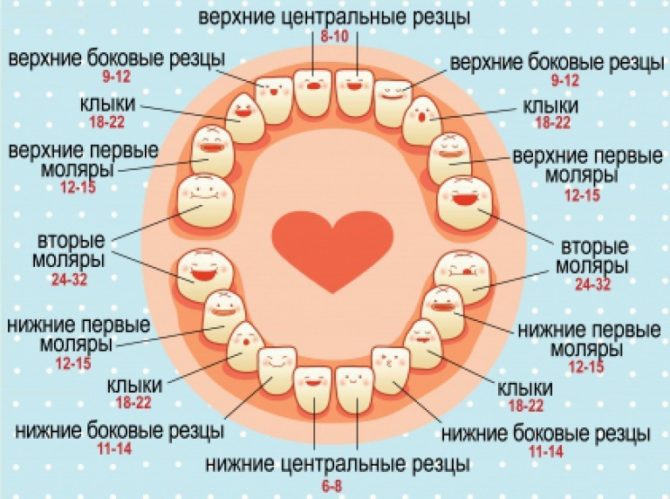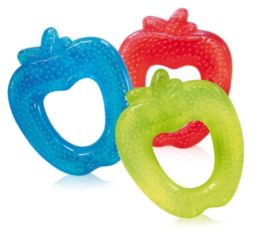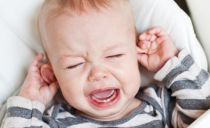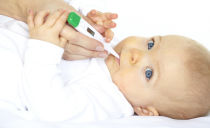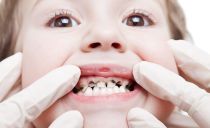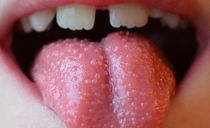Teething in a child: signs, order, how to help
The teeth are cut in all newborns. But some people endure this process steadily, while others are capricious, pull various objects in their mouths, constantly cry and sleep poorly. All without exception the temperature rises, the mucous membrane becomes inflamed, the cough begins. You might think that the baby caught a cold. Moreover, teething symptoms appear in children 1–2 months before parents see the first incisor. Therefore, each mother should know what signs are normal, and in which cases you need to see a doctor.
Content
- When should the first tooth come out
- The process of teething of temporary teeth: the order and timing
- When baby teeth grow: table
- Factors affecting the timing of first teething
- How to determine the period of appearance of the first teeth
- How to help a child
- Decay of deciduous teeth: when it begins and how long it lasts
- Hygiene rules
When should the first tooth come out
Milk teeth are laid before birth. And they begin to grow around the time when coarse food appears in the child’s diet - at 6 months. It happens that they leave early - in the fourth week of life, and sometimes with a delay - on the 36th. Timing is relative, so there is no need to worry if peers are developing faster. However, with excessive delay, it is better to go to the pediatric dentist to exclude the possibility of pathologies and abnormalities.
There is no discrepancy in which tooth appears first - this is the central incisor, which is located on the lower jaw and is designed to bite off food (see photo). Since all milk teeth erupt in pairs, after the right frontal incisor, the left should be expected. And then the brothers of the same name from above.
The process of teething of temporary teeth: the order and timing
As soon as the baby grows 4 central incisors, the side ones will begin to hatch. There are also four of them: a pair on each jaw. But unlike the front ones, they first appear from above, and only then from below. Usually children under one year acquire exactly 8 teeth. If this does not happen, you should consult your dentist.
When the reason for the delay is related to heredity or the climate, which affects the growth rate, there is no need to worry. But everything can be much more serious. For example, there is such an anomaly - adentiain which the rudiments of the teeth are partially or completely absent. The pathology is eliminated by installing prostheses.
When the child reaches the age of one year, the first chewing molars and fangs, which are necessary for tearing solid products, will begin to come out of him. The milk line will end with the second molars. During the growth of fangs, the baby is very naughty, as their sharp tip injures the soft tissues. The process is accompanied by an increase in temperature, which can rise to 39 ° C, profuse salivation and inflammation of the gums. These are the most painful teeth, therefore, during the period of their growth, the mother should make every effort to ease the condition of the child.
When baby teeth grow: table
Expect teething in infants should be at certain periods indicated in the table. The exact date may vary, but the time frame must be respected. Otherwise, you need to go to the doctor.
| The name of the tooth pair | Location | When will appear (in month) |
|---|---|---|
| Central incisors | From below | 6–7 |
| From above | 8–9 | |
| Side incisors | From above | 9–11 |
| From below | 11–13 | |
| First big molars | Both couples | 12–15 |
| Fangs | From above | 16–18 |
| From below | 18–20 | |
| Second large molars | Upper and lower | 24–30 |
At 2 years old, the child should have 20 teeth. Exactly such a number of "milkmen" grows in every crumb. More on the children's jaw simply would not fit, since it has a small size. But with age, the jaw grows, while the dentition also increases. By age 13, everyone can boast a Hollywood smile of 28 teeth. And to 18 - a complete set, consisting of 32 positions. Provided that he has erupted third molars, which are far from everyone.
Factors affecting the timing of first teething
Teeth appear in children at different times, since many factors influence their development:
- Heredity. If the mom’s or dad’s milk row formed later than the standard norm, the baby will also have a 30% probability.
- Pathology. Disorders in the gastrointestinal tract, rickets are accompanied by low digestibility of nutrients from food. Including calcium necessary for the normal development of bone tissue.
- Baby ration. First of all, this is the amount of minerals consumed. In the second turn - the way of feeding. According to statistics, in children who are breast-fed, temporary teeth grow almost a month faster than that of the "artificial". Frequent attachments contribute to the speedy thinning of the gum tissue, making the apex easier to break out.
- Climatic conditions. According to observations, in infants who live in hot countries, the milk line is formed earlier.
- Child gender. In girls, the first tooth erupts faster than in boys.
No need to worry about peers growing faster than your baby. According to statistics, every fourth child who is still toothless by the age of 12 months, doctors do not reveal any deviations. And the delay is explained by the individual peculiarity of the body.
How to determine the period of appearance of the first teeth
During the period of teething on the gums of the child, a tubercle may swell, which worries the parents, because it seems to them that pus has accumulated under it. This is actually a natural process. The gum tissue softens to make it easier for the tooth germ to break out. But if the swelling has become too big and unbearably painful, you can go to the dentist. It will release fluid and facilitate teething.
Teeth are cut: symptoms
Vivid symptoms that precede the appearance of deciduous teeth are observed in 70% of children. Usually she begins to bother the baby three weeks before the first incisor is biting, so parents can learn about the upcoming torments in advance and how to prepare for them.
The natural and non-dangerous signs of teething include:
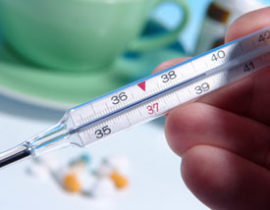 Increased body temperature - 39 ° C, which may be accompanied by fever.
Increased body temperature - 39 ° C, which may be accompanied by fever.- Increased salivation.
- Redness and swelling of the gums.
- Pain
- Intermittent sleep.
- Decreased appetite.
- Spitting up.
- Upset stool.
- Runny nose.
- Wet and rare cough.
- Allergic reactions, which are manifested by a rash on the cheeks.
The child begins to behave capriciously, often asks for pens, pulls rattles, nipples, toys, fingers in his mouth. Annoyingly reacts to sharp sounds, bright light. Most often, it is because of this behavior that parents decide to examine the baby's jaw. On it you can find not only inflamed gums, but also blood.
Dangerous symptoms
When a child's teeth are cut, his immunity decreases. The body becomes susceptible to pathogenic bacteria, germs and fungi. Therefore, parents should know what diseases can develop during this period and be able to determine the symptoms that accompany them. The most common pathologies:
- Thrush. According to statistics, it develops in half of babies. The causative agent is Candida fungus.The disease should begin with fairly vivid signs: a white curd on the tongue, gums and cheeks, loss of appetite, itching in the mouth. You need to contact a pediatrician. If the diagnosis is confirmed, he will refer you to a dermatologist.
- Caries. Appears on teeth with weak enamel. It is invisible at first, since the affected area acquires a brown color only at a deep stage. To prevent the development of the disease, you need to regularly visit the dentist and once a day to clean the oral cavity of bacteria.
- Stomatitis. The cheeks and tongue of the child cover the sores, surrounded by a white coating.
Fever, cough and upset should go away in two days. In rare cases, after five. You can’t wait any longer - consult your doctor right away.
How to help a child
During the eruption of the first teeth, the suffering of the baby should be alleviated. Try to give it teether. This is a special toy that helps accelerate the thinning of the gum tissue and improve blood circulation. They make it from safe plastic, in the form of geometric figures, rings, little animals. You can find a teether made of silicone material. It is filled with liquid and is intended for freezing. A cold toy helps relieve pain, reduce gum swelling.
Medicines
Many parents are opposed to drugs. But over time, they come to understand that the unpleasant symptoms that manifested in the baby due to teething will not go away on its own. And teethers help not all children. You can alleviate the condition of a newborn baby with painkillers or ibuprofen. But before that, you should consult a pediatrician, as parents may misunderstand the dosage rules and contraindications indicated on the insert.
Commonly used drugs:
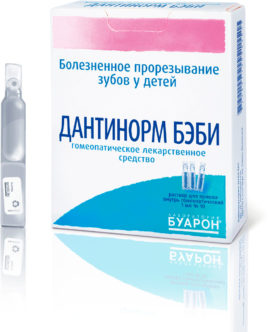 Dantinorm baby. Homeopathic remedy in the form of a solution. Anesthetizes for a long time, reduces the degree of manifestation of eating disorders.
Dantinorm baby. Homeopathic remedy in the form of a solution. Anesthetizes for a long time, reduces the degree of manifestation of eating disorders.- Dentokind. Homeopathic medicine. Designed specifically for babies who have teeth. Relieves almost all symptoms: temperature, nasal congestion, fever, diarrhea, soreness. Available in the form of lozenges. But since some children are small for this, the pill can be dissolved in a little water.
- Kamistad. Anesthetic, antiseptic and anti-inflammatory gel. The main active substances are chamomile extract and lidocaine. Do not give to children under 3 months!
- Dentinox. Available in the form of a gel and rinse. Relieve pain, reduce gum inflammation. 100% safe. Even if the child swallows a little substance.
- Holisal. Gel. After the procedure, the crumbs will have inflammation, the pain will decrease. It has an antiseptic effect. Attention! May provoke an allergic reaction - short-term burning.
- Calgel. The main active substance is lidocaine. Designed for children over 5 months. After application, the pain quickly returns, allergic manifestations are possible.
- Children's paracetamol. Suspension. Soreness passes, temperature decreases. Do not take longer than three days.
- Panadol. In the form of candles or suspensions. The active substance is paracetamol.
- Children's Nurofen. Contains ibuprofen. Relieves pain for a long time.
Never give an infant aspirin. This tool is absolutely not suitable for children as a painkiller and antipyretic.
Folk therapy
The first teeth grew back in those days when medicine was not developed. Therefore, there are many folk remedies that help alleviate the condition of the child and can be used as additional procedures:
- Hold a dummy or a teaspoon in the freezer and give it to the baby. A chilled thing will calm the gums and relieve pain. The baby will feel relief.True, the effect does not last long, and it is often impossible to carry out the procedure, since it is possible to provoke the development of a cold.
- Dampen gauze in chamomile broth and wipe it with a swollen gum. The plant has a pronounced antiseptic and calming effect. And massage movements will improve blood circulation.
- Prepare a motherwort broth: 1 teaspoon of grass per 0.5 liters of boiling water. Cool, add a little sugar and offer the baby.
- Spread natural honey on the gum. It will completely relieve irritation. But first you need to figure out if the child has an allergy.
- Let the baby gnaw the chicory root. Let him massage the gums and soothe the pain a little. Plus distracted.
There are also harmful folk recipes. Therefore, we list what can not be done when a baby grows a tooth:
- Press on the inflamed gum. This will only intensify the pain.
- Giving cookies and other solid foods. The child may choke and damage the tooth.
- Wipe the gums with regular soda. The irritation will increase.
You need to know
Here are a few tips to use when teething in a child:
- When a child's teeth are cut, it is necessary to provide his body with a normal amount of calcium and vitamin D.
- If the tooth erupts right before the vaccination, you will have to postpone it until better times.
- You can not take the baby from the chest.
- And it is advisable not to give him a nipple, because it can cause irreversible changes in the development of the bite and the upper palate.
Decay of deciduous teeth: when it begins and how long it lasts
A change of teeth can last from 7 to 9 years. The first molars appear one year before the baby's teeth begin to fall out. They grow in empty places, which are formed as a result of an increase in the jaw. Immediately after the last milk molars, at 5–7 years, the lower, and six months later, upper incisors are replaced. Those located in the center. Lateral begin to fall out after 6, and their replacement lasts about 24 months.
When the child celebrates his first anniversary, he will begin to grow permanent premolars, which will take the place of dairy. Then the second molars, fangs and finally the wisdom teeth. The latter can appear with the onset of adulthood, and sometimes they do not cut at all. And that is the norm.
Up to 6 years, milk teeth should not stagger and fall out. You need to panic if the order of growth of permanent teeth is disrupted. All these are signs of pathology. If you find them in your child, take him to a doctor.
Hygiene rules
Oral care should be started immediately - as soon as the child has the first tooth. Please note that indigenous premolars, fangs and incisors are laid at birth, therefore caries can affect not only milk teeth, but also permanent ones.
Initially, you can use special hygienic napkins soaked with xylitol for care. When the first 8 incisors erupt in a newborn, you need to get a soft baby brush. It is recommended to brush your teeth no more than once a day, so as not to damage the enamel. AND no paste.
To protect the baby's first teeth from caries, it is necessary to limit the intake of sweets. Especially at night. Carbohydrates create an ideal environment for the propagation of pathogenic microorganisms. Especially during sleep, when salivary glands with bactericidal properties begin to work less actively. Protect the health of the baby’s dentition with just 1 tooth!



